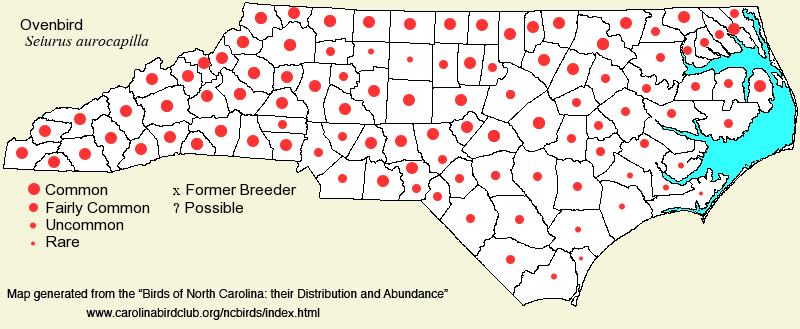 |  |
|
Ovenbird - Seiurus aurocapilla PARULIDAE Members: | Search Common: Search Scientific: |
|
|
|||||||
| General Comments | The Ovenbird recently "lost" its two nearest relatives -- the Louisiana and Northern waterthrushes -- to a new genus; thus, it now stands alone in the genus Seiurus. It has a wide breeding range over nearly all of the eastern United States and much of Canada. Small numbers winter in the Southeastern states, but the bulk winter in the tropics. It is named after the shape of its ground nest -- "oven-like", being a rounded mass of leaves with a small opening in the side. It nests in large numbers over nearly all of North Carolina, always in forests with a leafy ground cover; these forests always have a moderate (but not dense) shrub and understory layer, beneath a varied canopy, in many settings (except overly wet places). Favored habitats are middle-aged to mature pine-hardwood stands, oak-hickory forests, and drier portions of floodplain forests. They will often nest in pure pine stands, as long as there is a deciduous, broadleaf understory and shrub zone growing beneath the pines. They are infrequent in rhododendron or mountain laurel stands, preferring deciduous layers. A few overwinter along the coast in the state, mostly in Buxton Woods, where the forests or woods have a dense shrub layer that is almost impenetrable to humans, but which allows the birds to walk along the ground. | ||||||
| Breeding Status | Breeder | ||||||
| NC BRC List | Definitive | ||||||
| State Status | |||||||
| U.S. Status | |||||||
| State Rank | S5B,S1N | ||||||
| Global Rank | G5 | ||||||
| Coastal Plain | Summer resident, and sparse winter visitor/resident. In summer, generally common over the northwestern part of the region; fairly common in southern (including Sandhills), central, and the Tidewater zones, and generally uncommon in the southern coastal counties. Probably absent as a breeder on coastal islands; rare to absent on the mainland in portions of the southernmost counties, though it may nest in all counties (but New Hanover?). Quite numerous as a migrant (large numbers were formerly "tower-killed"). In winter, uncommon but regular at Buxton Woods in Dec (as tallied on CBCs), and a few presumably overwinter -- especially as there was an excellent tally of 12 birds at this site on 8 Feb 2022, and seven at this site on 20 Feb 2021. Elsewhere, very rare in winter, almost always very near the coast, and probably does not regularly overwinter, though one overwintered at Manteo from 30 Jan - 3 Mar 2014 and again through the winters of 2014-15, 2015-16, and 2016-17 (probably the same bird). Mainly early Apr to mid-Oct, sparingly into winter. Peak counts: | ||||||
| Piedmont | Summer resident. Common over the region as a whole. Reasonably widespread, and common also in foothill ranges; least numerous in some heavily urbanized counties in the central Piedmont. Mainly early Apr into Oct (departure dates not well known because the birds are rather silent and overlooked in Oct). There are 12 winter records, of single birds; the Riverbend Park (Catawba) bird was remarkable, having clearly survived the entire winter, present from 8 Dec 2013 - 30 Mar 2014. Peak counts: 168, Jordan Lake spring count, 7 May 2000. | ||||||
| Mountains | Summer resident. Common at low to middle elevations, to about 4,000 feet, and fairly common to about 4,500 feet, rarely higher. Can occur higher after breeding or in fall migration. Mainly mid-Apr to mid-Oct. Two winter reports: one, Glen Cannon (Transylvania), 20 Nov 1995 - 8 Jan 1996; and one, Cullowhee (Jackson), 21 Jan 2019. Peak counts: | ||||||
| Finding Tips |
None needed; easily heard in a morning of birding in most areas of the state in May and Jun. **** | ||||||
| Attribution | LeGrand[2025-05-09], LeGrand[2024-05-14], LeGrand[2022-04-27] | ||||||
| NC Map Map depicts all counties with a report (transient or resident) for the species. | Click on county for list of all known species. |
| NC Breeding Season Map Map depicts assumed breeding season abundance for the species. |  |